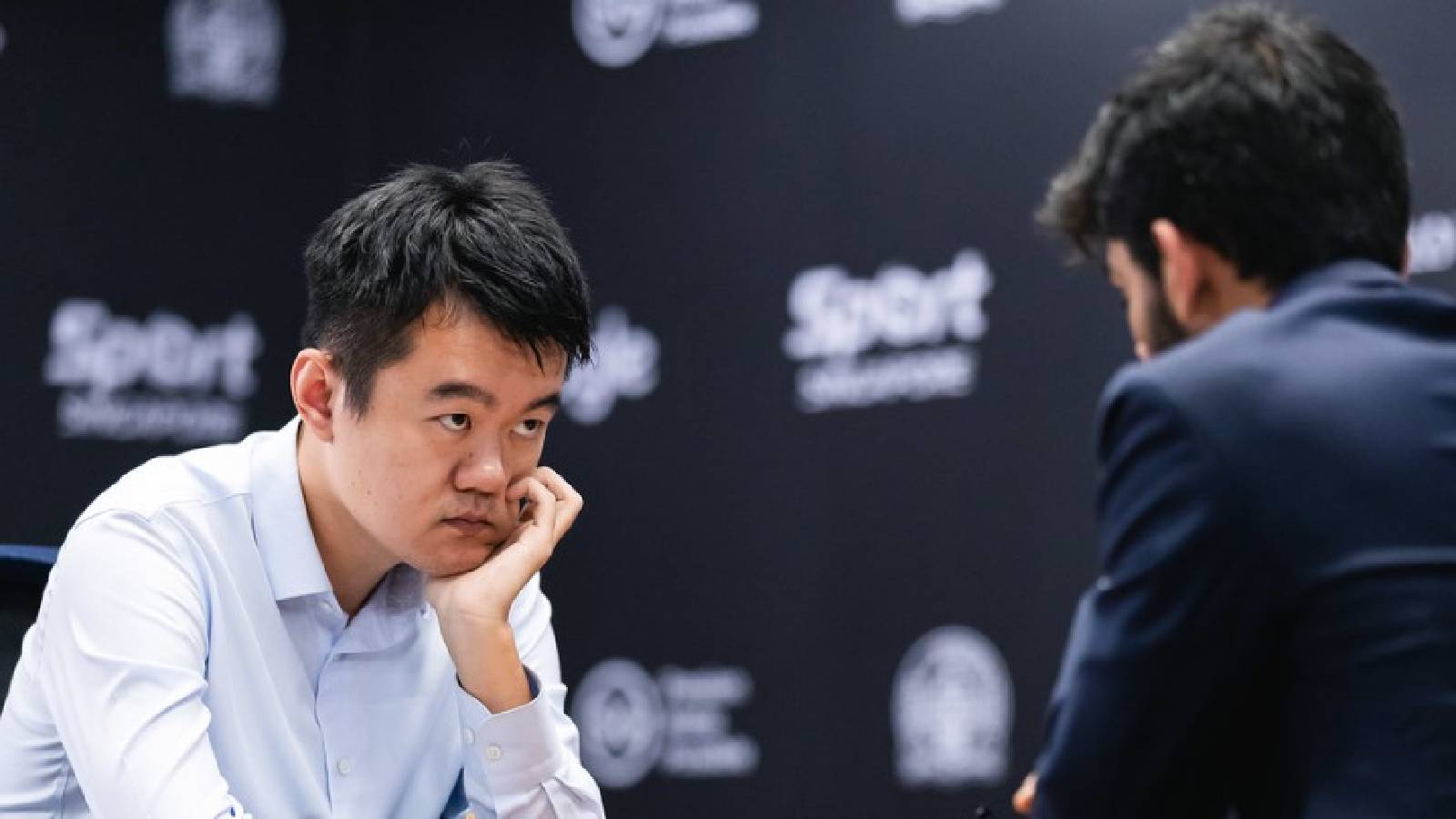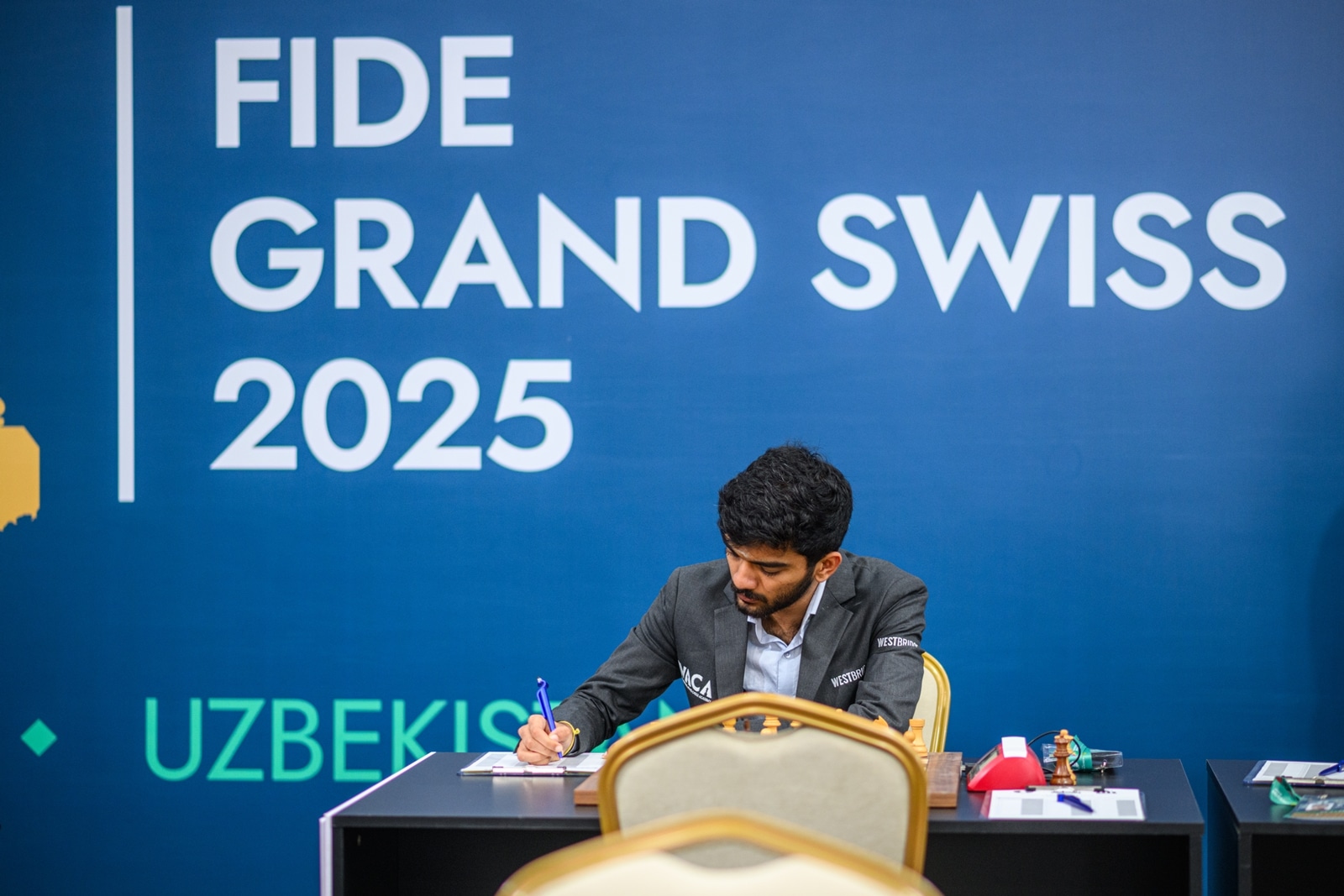Over the course of two bleak weeks in Samarkand, Gukesh Dommaraju, the reigning world champion, has dropped 16 ELO rating points, courtesy the three defeats and the four draws he sustained over the course of the 11-round FIDE Grand Swiss tournament.
It’s a run of results that fans have likened—uncharitably—to the decline in form and confidence suffered by Gukesh’s predecessor Ding Liren, who seemed to struggle with the weight of the world champion’s crown until relinquishing the throne to the teenager from Chennai. Ding, in fact, was perhaps the only incumbent world champion who had come into the world championship battle as the overwhelming underdog.
But Gukesh’s dip in form is perhaps miles away from the plummet of Ding Liren after the Chinese GM became the world champion. The results at the FIDE Grand Swiss too must be seen with some nuance, rather than shock and alarm.
 Ding Liren and Gukesh in action during Chess World Championship in 2024. (FIDE/Eng Chin An)
Ding Liren and Gukesh in action during Chess World Championship in 2024. (FIDE/Eng Chin An)
The wild, wild Swiss
For one, the Grand Swiss tournament is one of the most treacherous tournaments to do well in. It’s particularly demanding for the favourites and front-runners because each player faces off against a player with similar points against their name in that round. This means to stay on top of the standings over the course of 11 rounds is practically impossible. Look at the Iranian grandmaster Parham Maghsoodloo, for instance. He was on top of the standings for four rounds till he lost to Nihal Sarin. He ended the tournament in 27th spot, with six points which is exactly the same number of points that Gukesh had. (Other players who ended with as many points as Gukesh were Praggnanandhaa and two-time world championship contender Ian Nepomniachtchi.)
The event saw at least seven players share the lead between the third round and the 11th, a demonstration of the wild leaderboard churn that only a tournament played in the Swiss format can bring about.
The Grand Swiss is also an event that puts unique strains on the minds of players: they only learn who they are playing in the next round late at night the previous day and then turn up to battle the next day in the afternoon. Gukesh’s entire Candidates and World Championship campaigns were based on the solid foundation of opening prep and knowing the opponent as well as they perhaps knew themselves. This probably made it hard for the calculation-heavy Gukesh to turn up at the board as well-drilled in his war-plans as he would ordinarily have.
 Gukesh’s entire Candidates and World Championship campaigns were based on the solid foundation of opening prep and knowing the opponent as well as they perhaps knew themselves. (Photo Credit: FIDE/Michal Walusza)
Gukesh’s entire Candidates and World Championship campaigns were based on the solid foundation of opening prep and knowing the opponent as well as they perhaps knew themselves. (Photo Credit: FIDE/Michal Walusza)
When it comes to the cauldron of the World Championship, it’s unlikely that anyone who makes it through the Candidates will find Gukesh as under-prepared as he was at the Grand Swiss. It must also be pointed out that the next World Championship game where Gukesh will have to defend his crown is more than a full year away, which also explains why Gukesh has prioritised playing in as many formats as he can —Freestyle Chess, rapid and blitz, and even the occasional online Titled Tuesdays—rather than just sticking to classical chess, which is his best format.
Story continues below this ad
A bittersweet 2025 for Gukesh
Gukesh’s results since becoming the world champion must rankle the boy from Chennai himself. He has had great days in 2025: almost winning the Tata Steel chess tournament in Wijk aan Zee, contending for the title till the final round at the Norway Chess event and then topping the standings at the SuperUnited Rapid and Blitz Croatia event. But the headline-making results this year have primarily been the bruising losses at tournaments. He’s also defeated Magnus Carlsen in classical and rapid formats once besides defeating other strong players like Fabiano Caruana repeatedly this year. Those are signs that Gukesh is not a player in decline, just a young player still seeking equilibrium in his results.
Some of these results are also his own doing: more than once at the recently-concluded Grand Swiss, Gukesh was the one who was pushing for a decisive result rather than settling for draws as other strong players would have in his shoes.
Fabiano Caruana, a man who skipped the 2025 Grand Swiss after finishing 10th in 2023 and second in 2021, recently broke down Gukesh’s tendency to keep on fighting even in positions where other players would take the safe route. Caruana pointed at the much-talked about Gukesh defeat to 16-year-old Abhimanyu Mishra at Samarkand to talk up Gukesh’s appetite to prolong drawn games. He pointed out how the world champion had blundered on the 12th move itself by moving the g pawn instead of the h pawn. Caruana called some of that middle game thinking “inexplicable”. But despite that early error, there was a draw on the table by the time 31 moves were played with the positions being level with Gukesh holding two additional knights while Mishra had a bishop and four additional pawns on the board.
“White (the colour Mishra was playing with) has the two passed pawns and black has very few pawns left. So, it’s a very drawish position. You would say 99 per cent of times between two grandmasters of this strength, they finish the game as a draw. But Gukesh made a move which I think we can attribute to him wanting to keep pieces on and maybe try to swindle Mishra in a time scramble. He was in such a losing position at the start of the game and he’s not better here as well. So if you ask me, he should be taking his draw and running home with his prize, because for the majority of the game it was not looking like Gukesh would even draw this game, you know?” Caruana said on the C Squared Podcast.
Story continues below this ad
“Whatever you say about Gukesh, he is an incredibly fighting player. He fights—and I think that’s admirable—he fights against anyone to the bitter end. But objectivity is a very important thing as well.”
© The Indian Express Pvt Ltd









